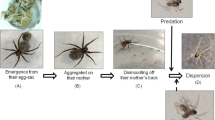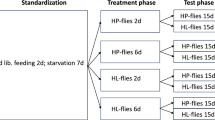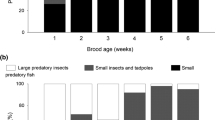Summary
Feeding experiments were carried out on various stages of the wolf spider Pardosa lugubris in order to construct an energy budget for the spider. Under the rearing conditions the spiders developed at a similar rate to those in the field. P. lugubris females ingest 308 cal during their life. 73.0% of this energy, goes into respiration and 25.7% into production. Males ingest 98 cal of which 81.3% goes into respiration and 16.1% into production.
P. lugubris ingests a large proportion of the food it kills and it resembles other arthropod carnivores in having high growth efficiencies.
The annual rate of energy flow through a wolf spider population was calculated. 1.39 Kcal/m2/year are “killed” of which 81.2% is ingested. Of this ingested energy 71.1% goes into respiration and 26.4% into production.
The difficulties involved in the assessment of the results of single-species energetics studies are discussed.
The annual population energy budget of P. lugubris is compared with that of Pyrrhosoma nymphula, an aquatic arthropod carnivore with a similar lifecycle to P. lugubris. Although the magnitudes of the various components of the energy budget are larger in P. nymphula, there are similarities between the two species. Thus, the amount of energy “killed” per unit of predator biomass is similar and a similar proportion of this energy is returned to the ecosystem, although proportionally more goes into decomposers in P. lugubris.
Similar content being viewed by others
References
Bristowe, W. S.: The comity of spiders, Vol. 1. London: Ray Society 1939.
Dahl, F.: Die Lycosiden oder Wolfspinnen Deutschlands und ihre Stellung im Haushalte der Natur. Nova Acta Acad. Caesar. Leop. Carol. 88, Nr. 3 (1908).
Edgar, W. D.: Prey and predators of the wolf spider Lycosa lugubris. J. Zool. 159, 405–411 (1969).
Edgar, W. D.: Seasonal weight changes, age structure, natality, and mortality in the wolf spider Pardosa (Lycosa) lugubris in central Scotland. Oikos (in press, 1971 a).
Edgar, W. D. The life-cycle, abundance and seasonal movement of the wolf spider Lycosa (Pardosa) lugubris in central Scotland. J. Anim. Ecol. (in press, 1971 b).
Englemann, M. D.: The role of soil arthropods in the energetics of an old field community. Ecol. Monogr. 31, 221–238 (1961).
Hughes, R. N.: An energy budget for a tidal-flat population of the bivalve Scrobicularia plana (Da Costa). J. Anim. Ecol. 39, 357–381 (1970).
Lawton, J. H.: Feeding and food energy assimilation in larvae of the damselfly Pyrrhosoma nymphula (Sulz.) (Odonata:Zygoptera). J. Anim. Ecol. 39, 669–689 (1970).
Lawton, J. H.: Ecological energetics studies on larvae of the damselfly Pyrrhosoma nymphula (Sulz.) (Odonata: Zygoptera). J. Anim. Ecol. (in press, 1971).
Llewellyn, M.: The energetics of honeydew production in the lime aphid (Eucallipterus tiliae). J. Anim. Ecol. 38, 28P (1969).
Locket, G. H., Millidge, A. F.: British spiders, vol. 1. London: Ray Society 1951.
McNeill, S., Lawton, J. H.: Annual production and respiration in animal populations. Naturc (Lond.) 225, 472–474 (1970).
Parry, D. A.: On the drinking of soil capillary water by spiders. J. exp. Biol. 31, 218–227 (1954).
Phillipson, J.: A miniature bomb calorimeter for small biological samples. Oikos 15 130–139 (1964).
—: Ecological energetics, London: Edward Arnold 1966.
Phillipson, J. Studies on the bioenergetics of woodland Diplopoda. Secondary productivity in terrestrial ecosystems, vol. 2, p. 679–683. ed. K. Petrusewicz Warsaw & Cracow 1967.
Richter, C. J. J.: Relation between habitat structure and development of the glandulae ampullaceae in eight wolf spider species (Pardosa, Araneae, Lycosidae). Oecologia (Berl.). 5, 185–199 (1970).
Slobodkin, L. B.: Ecological energy relationships at the population level. Amer. Naturalist 94, 213–236 (1960).
Snedecor, G. W.: Statistical methods, 5th ed. Iowa: Ames 1956.
Yaginuma, T.: The spider fauna of Japan. Osaka: Arachnological Society of East Asia 1962.
Author information
Authors and Affiliations
Rights and permissions
About this article
Cite this article
Edgar, W.D. Aspects of the ecological energetics of the wolf spider Pardosa (Lycosa) lugubris (Walckenaer). Oecologia 7, 136–154 (1971). https://doi.org/10.1007/BF00346356
Received:
Issue Date:
DOI: https://doi.org/10.1007/BF00346356




